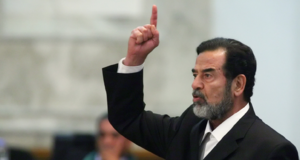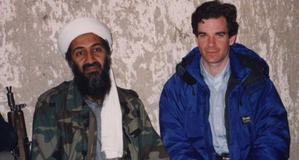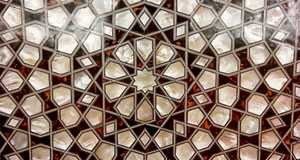The Islamic Middle Ages, a Fractured Polity, and the Flourishing of a Cultural and Scientific Renaissance
By
2012, Vol. 4 No. 09 | pg. 2/2 | « Farther west, in North Africa under the Murabitun dynasty, “literacy in the Arabic script and the custom of authorship in the Arabic language” developed (Norris & Chelmata, 2012). Later under the Muwahiddun dynasty in the 12th century, cultural reform arose. Founded by Ibn Tumart, this movement justified its liberalism on the works of al-Ghazali, a prominent Sufi theologian and thus opened ways for philosophical thought in the region (Shatzmiller, 2012). Philosophers such as Ibn Tufayl and Ibn Rushd flourished during this period amidst others who expanded on poetry, history, geography and the sciences (Shatzmiller, 2012). A unique literary tradition evolved particularly due to the contacts between regions of Muwahiddun occupation from Spain to North Africa (Shatzmiller, 2012). Beyond literature, Muwahiddun palaces adopted Hispano-Moorish techniques in architecture and were built by Spanish craftsmen. In Spain, literature and architecture provides further evidence of the merging of cultures and the fruits that diversity can yield. During the reign of al-Hakam II in the 10th century, Spain became the “ornament of the world” with the rise of philosophical and literary centers (Torres Balbas, Levi-Provencal, & Latham, 2012). Spanish art, for example in the making of caskets and jars of ivory featured unique Arabesque designs. This was a distinct form of decoration imaging abstract, geometric designs printed on books, textiles and carpets (Abdullah, 2012f). Despite differences, the merging of a diverse people developed a flourishing cultural mosaic. Fortifying this diverse group of people was a stable civil society. Two important aspects of social unity were the A’yan system of civil administration and the Futuwwa clubs (Abdullah, 2012e). The A’yan known as “men of influence” were leaders or notables of high ranks in neighborhoods across the Middle East (Abdullah, 2012c). They were either merchants who provided financial support, descendents of a noble lineage such as “Sharifs” (descendents of the Prophet) or men of knowledge or “ulama” who served as religious authorities in the community (Abdullah, 2012d). These notables were usually property owning families who exercised control over the local market and mosque in the town. They addressed issues of the commoners and acted as mediators in disputes. Since the masses supported these notables, they gained political significance and used their power to ensure the “Amir” or governor of the province responded to the needs of the inhabitants (Bowen, 2012).Coupled with this system was a less formal organization of youth groups into “Futuwwah” clubs (Abdullah, 2012e). These clubs brought together youth involved in a common trade or profession who represented the poor, down trodden parts of the nation and sought to speak up against the rich and powerful (Abdullah, 2012e). Their aim was to bring civic discipline to the towns and they were held together through an unconditional sense of loyalty towards one another. Thus at the grassroots level, there was an independent, stable society having strong links with each other which held out in the face of hardship. This contrast between the division of government and the unity of society and culture thus erupted into a period of cultural enlightenment and development. The dissolution of empires was a period of chaos where society was dismantled, as seen in the example of the fall of the Roman Empire. With the decline of the Abbasids, surely there was economic and social instability in areas such as Baghdad, Iraq, and Syria but nevertheless it was also a period of enlightenment (Kennedy, 2004). This enlightenment arose from a sense of nonpolitical unity triggered due to the fracturing of the state. The fragmentation ensured political independence for the people. With the spread of Islam, a diverse population arose, unified by a sense of ideological unity based on their religion, language and common allegiance to the caliphate. Coupled with this was a solid social foundation established by the A’yan civil administration and the Futuwwa clubs on the commoner level. Thus with social stability and political independence, a diverse population merged to produce a period of intellectual growth and development, despite ravaging conflict and division on the forefront. ReferencesAbdullah, T.A.J. (2012a, January). The Islamic Middle Ages: Iraq & Iran. [Lecture]. York University, Toronto, Ontario, Canada. Abdullah, T.A.J. (2012b, January). Sufi Islam. [Lecture]. York University, Toronto, Ontario, Canada. Abdullah, T.A.J. (2012c, January). The Political System in an Age of Division. [Lecture]. York University, Toronto, Ontario, Canada. Abdullah, T.A.J. (2012d, February). India and Central Asia. [Lecture]. York University, Toronto, Ontario, Canada. Abdullah, T.A.J. (2012e, February). Society and Economics in the Middle Ages I. [Lecture]. York University, Toronto, Ontario, Canada. Abdullah, T.A.J. (2012f, March). Literature, Music, Art and Architecture. [Lecture]. York University, Toronto, Ontario, Canada. Bowen, H. (2012). A’yān. In P. Bearman, T. Bianquis, C.E. Bosworth, E. van Donzel, & W.P. Heinrichs (eds.), Encyclopaedia of Islam, Second Edition. Brill Online. Retrieved March 24, 2012, from http://brillonline.nl.ezproxy.library.yorku.ca/subscriber/entry?entry=islam_SIM-0893 Hodgson, M. G. S. (1974). The Venture of Islam, Volume II: The Classical Age of Islam. Chicago: The University of Chicago Press. Retrieved from http://quod.lib.umich.edu/cgi/t/text/text-idx?c=acls;idno=heb00894.0002.001;cc=acls. Ikram, S.M. (1964). Muslim Civilization in India. New York: Columbia University Press. Retrieved from http://www.columbia.edu/itc/mealac/pritchett/00islamlinks/ikram/part1_02.html Kennedy, H. (2004). The Prophet and the Age of the Caliphates. Toronto: Pearson Longman. Norris, H.T., & Chalmeta, P. (2012). al-Murābiṭūn. In P. Bearman, T. Bianquis, C.E. Bosworth, E. van Donzel, & W.P. Heinrichs (eds.), Encyclopaedia of Islam, Second Edition. Brill Online. Retrieved March 26, 2012, from http://brillonline.nl.ezproxy.library.yorku.ca/subscriber/entry?entry=islam_COM-0798. Schimmel, A. (1992). Islam An Introduction. Albany: State University of New York Press. Shatzmiller, M. (2012). al-Muwaḥḥidūn. In P. Bearman, T. Bianquis, C.E. Bosworth, E. van Donzel, & W.P. Heinrichs (eds.), Encyclopaedia of Islam, Second Edition. Brill Online. Retrieved March 25, 2012, from http://brillonline.nl.ezproxy.library.yorku.ca/subscriber/entry?entry=islam_COM-0824. Torres Balbás, L., Lévi-Provençal, E., & Latham, J.D. (2012). al-Andalus or Ḏj̲azīrat al-Andalus. In P. Bearman, T. Bianquis, C.E. Bosworth, E. van Donzel, & W.P. Heinrichs (eds.), Encyclopaedia of Islam, Second Edition. Brill Online. Retrieved March 26, 2012, from http://brillonline.nl.ezproxy.library.yorku.ca/subscriber/entry?entry=islam_COM-0054. Suggested Reading from Inquiries Journal
Inquiries Journal provides undergraduate and graduate students around the world a platform for the wide dissemination of academic work over a range of core disciplines. Representing the work of students from hundreds of institutions around the globe, Inquiries Journal's large database of academic articles is completely free. Learn more | Blog | Submit Latest in History |


















